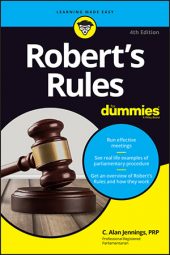Ordering a recount
Sometimes the solution is easy. If the election just took place and members are still in their seats, you can resolve any question about the actual vote count by ordering a while-you-wait recount. Everything else pretty much gets put on hold when that happens. It’s okay — now is the best time to stop and be sure.If you can’t resolve the count issue with a recount, you’re probably still okay to retake the vote using another method (unless you’ve gone on to the next item on your agenda and are involved in that).
Challenging by raising a point of order
The way to challenge elections your organization has held generally adheres to procedures for raising pints of ardor — or, rather, points of order.Usually, you have to catch the error when it happens — and speak up right away — if it is to make a difference in the outcome. But in a few cases, you can make the challenge anytime, and it has to be dealt with then — whenever it is! Those circumstances are as follows:
The individual who was elected doesn’t meet qualifications for office. Just ask President Myrtle what happened when she forgot to pay her dues and her membership lapsed. She then wasn’t a member anymore, so according to the bylaws, she wasn’t entitled to serve in any office — certainly not as the president. The vice president automatically become the president and didn’t even know it! Myrtle never forgot to pay her dues again. But it didn’t matter, because she never got elected to anything again, either.
According to Robert’s Rules, unless some qualification for holding office is established in the bylaws, the members can elect anyone they choose to any office. If the bylaws establish qualifications for holding an office, the qualifications must be met. So if the bylaws provide that officers must be members to hold office, then officers must be members to serve in that office.
You already conducted a valid election for the same term. Believe it or not, if you revote something against the rules, that result probably isn’t valid. In this case, whatever you did in the first place still stands.
The votes of nonmembers or absentees affect the result. Whether it’s zombies in New Orleans voting for years after they died or just the folks who live in St. Tammany parish voting in St. Bernard parish, if the result changes when you eliminate ineligible votes, the election outcome changes. If the ineligible votes cannot be identified, and enough of them were cast to affect the result, the election has to be redone. That’s because the offending votes, being unidentifiable, cannot be thrown out.
An election took place to fill a vacancy without proper notice. Everybody remembers the story that went something like, “Hey, let’s elect Figero before Alexander and Cicero figure out what we’re doing.”
Disenfranchisement of members changes the result. All it takes for this situation to happen is for the treasurer to have an incorrect membership list and find out later that eligible people weren’t allowed to vote. Guess what! It’s probably not too late to fix it, and the way you do that is to hold a new election.
Making it final
Elections are a big deal. But going on and on arguing about who won keeps the real work from getting done. At some point, the body doing the electing has to elect somebody who can serve so that everybody can go home. If the assembly doesn’t want to have to deal with the problem itself, it can refer the decision to a subordinate body with authority to make the final determination.But unless the bylaws or special rules of order or direct authority from the assembly expressly grant the subordinate body the power to act for the superior body in its elections, none but the electing body can make it final. Finally!
None other than the electing body can invalidate an election. If, after the general membership’s meeting adjourns, the board later discovers one of the continuing breaches listed above under the heading “Challenging by raising a point of order,” it can’t fix the problem itself – it has to report it to the general membership.

